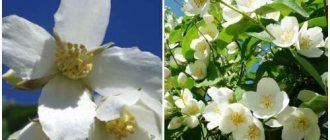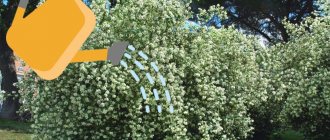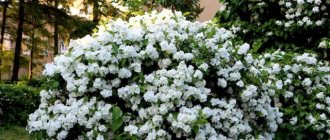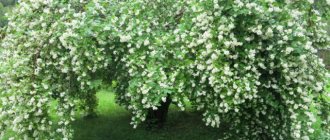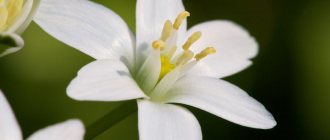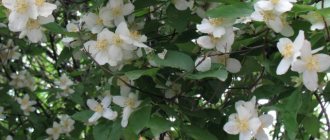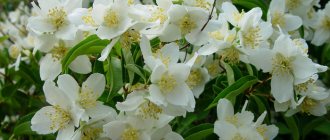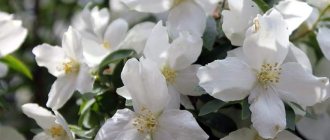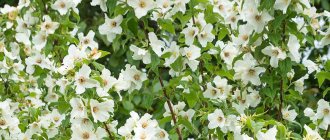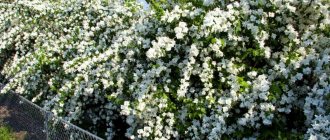General description of terry mock orange
In fact, mock orange is not a jasmine, but people call it that because of the aroma of fragrant flowers, which is very similar to the fragrance of real jasmine flowers. However, these ornamental plants belong to different families, just as the zones and conditions for growing crops are different.
Garden jasmine or terry mock orange is a deciduous shrub with a height of 1.5 to 3 m, obtained by the French breeder Lemoine through experiments with common mock orange. The ornamental plant is distinguished by double flowers that resemble miniature roses in a half-bloomed state. There are double and semi-double varieties of garden jasmine with large-flowered forms and flowers with a small corolla, with a different number of petals, which affects the doubleness.
How terry mock orange blooms
The flowering of terry mock orange is unforgettably beautiful and long-lasting. Depending on the variety, the flowers, collected in inflorescences of several pieces, have varying degrees of terry. On average, garden jasmine blooms for 2-3 weeks, starting in mid-late June. It is worth saying here that double varieties of mock orange are not capable of emitting a strong aroma, unlike the inflorescences of ordinary mock orange. Their fragrance is subtle, barely perceptible, light. Mock orange pleases with lush, lush flowering only in sunny places and fertile soils.
Popular varieties of terry mock orange
The most popular and in demand varieties of terry garden jasmine among gardeners are:
- Virginal is the first variety of terry mock orange, obtained by Lemoine more than 100 years ago. A bush up to 3 m in height with large flowers blooms 2 times a year: in summer and autumn. Its aroma is sweet, quite strong, which is uncharacteristic for representatives of the double type of garden jasmine;
- Garden jasmine Minnesota snowflake. This terry mock orange shrub grows up to 2 m in height and is distinguished by dense double snow-white flowers, collected in inflorescences of several pieces;
- Pyramid. This is a tall, up to 3 m, late flowering shrub. Snow-white flowers abundantly cover the powerful bush, emitting a subtle, subtle scent;
- Schneeshturm. A bush of double mock orange up to 3 m in height, with drooping shoots that are abundantly decorated with luxurious double flowers that emit a refreshing, fruity aroma;
- Ermine mantle. A low, up to 1.8 m in height, variety with drooping branches, lushly decorated with creamy white flowers that exude a subtle strawberry aroma;
- Blizzard. This is a tall shrub, completely covered with snow-white inflorescences, which from a distance resemble large flakes of snow. Almost all the leaves of the terry mock orange are hidden under the luxurious “snow cover”;
- Moonlight. A variety with small pom-pom flowers that appear in huge numbers and exude a strawberry aroma and glow in the dark.
According to experienced gardeners, in the conditions of the domestic climate, varieties of terry jasmine of Russian selection take root and bloom best. These are Blizzard, Yunnat, Moth Ballet and others.
What does jasmine look like and types of shrubs
Jasmine has flexible long stems reaching a length of 1.5-2 m. Each species, and there are more than 2 hundred of them, has different types of flowers and leaves. The leaves are light or very dark, simple or trifoliate, pinnate, with or without pubescence. The flowers are tubular, with stamens on short stalks. There are 6 types of flowers popular in our country.
Bright yellow flowers, collected in an umbrella of 5 pieces, bloom from the third decade of May to the first ten days of July.
Holofloral
Holoflowered jasmine is frost-resistant (down to -15 °C) and drought-resistant. It reproduces well in a variety of ways. It has long and thin branches that droop and resemble a green waterfall. There are a lot of flowers. They are large and bright yellow.
The leaves are small, bright green, trifoliate.
Medicinal, or White
Jasmine officinalis (White jasmine) – climbing, has long, thin, smooth, angular shoots. The leaves are paired, oblong-lanceolate, smooth, ciliated along the edge, rich green above, light green below. Fragrant white flowers are collected in 5-6 pieces in umbrella inflorescences.
Blooms from April until the end of summer.
Pink
Pink Bisa jasmine attracts with its delicate aroma and pink flowers (there are shades of different richness). Blooms in May. The leaves are dark green, ovate, slightly pubescent.
The branches reach a length of 1.5-2 m.
Sambac
Jasmine Sambac (aka Climbing Garden Jasmine, Arabian), and especially its popular variety Grand Duke, is valued for its incredibly strong aroma. The flowers of this jasmine are white, of double or semi-double type, appearing in groups of 3 to 12 in an inflorescence. They open only at night and close in the morning. The leaves are ovate, smooth.
In optimal conditions it can bloom throughout the year.
Multifloral
Jasmine Multiflorum (on sale you can often find the name Polyanthus or Polyanthus) is a vine and is grown as an hanging plant. A popular indoor plant, but in warm regions it can grow in open ground and decorate walls and fences. It grows quickly, reaching 1.8 m in a year. It is covered with white tubular star flowers that smell pleasant.
Flowering occurs in February-August.
It will also be interesting: Jasmine (shrub) - planting and care, propagation and pruning?
Main characteristics
The main advantage of the terry mock orange is its unpretentiousness - in order for the luxurious beauty of the snow-white flowering of the crop to be, according to the description above and in the photo, there is no need to perform complex agrotechnical techniques. Garden jasmine is a frost-resistant shrub that can withstand frosts up to 22 - 25 degrees, depending on the variety. This type of ornamental shrub has good immunity and is characterized by resistance to pests and diseases. However, it is important to carry out agricultural care techniques: remove fallen leaves in a timely manner, avoid waterlogging, provide the plant with the necessary amount of nutrients, which will ensure even greater plant resistance to infections.
Chubushnik: a variety for the garden
If you are not a fan of gardening, you should choose mock orange, planting and caring for which does not take much time. Suitable varieties are Ordinary and Small-leaved , which can withstand frosts down to -25°C. For those who don’t mind tinkering with mulching and winter shelter, any shape is suitable.
Some types and varieties of mock orange that have proven themselves in landscape design in the Moscow region:
- Common : varieties Virginal, Flora-plena, Bicolore, Grandiflora, Aurea, Sybille, Salicifolia, Pumila, Belle Etoile, Duplex, Beauclerk.
- Crown : varieties Snowbelle, Aureus, Innocence, Nanus, Variegata,
- Lemoine : varieties Avalanche, Schneesturm, Pyramidal, Erectus, Alabasrite, Gletcher, Snow Avalanche, Flight of Moths, Blizzard, Elbrus, Airborne Assault, Arctic; dwarf Dame Blanche, Manteau d'Hermine, Moonlight, Dwarf, Dwarf.
- Virginia.
- Schrenk.
- small-leaved.
- Thin-leaved.
- Odorless.
- Gordon.
- Fluffy.
Reproduction methods
You can propagate garden jasmine of double varieties in one of the following ways:
- seeds;
- layering;
- cuttings;
- dividing the bush.
Seed propagation is quite labor-intensive and requires a long waiting time. Only after 6 - 7 years will the plant be pleased with abundant, lush flowering. For layering, the strongest, strongest shoots are selected, which are fixed in a shallow trench around the bush at the base of the first bud. Shoots for rooting are sprinkled with peat and moistened. During the season they are hilled up twice and cared for in the standard way. With the arrival of autumn, young seedlings are separated from the mother bush and planted in separate beds for growing.
For cuttings in June, cut branches 10 cm long along an oblique line. Planting material is planted in a greenhouse, after keeping them in a root-stimulating solution. Seedling care is standard: moistening, airing and hardening after rooting. Strong, healthy seedlings are planted in a permanent place only the next year.
The most effective and less time-consuming method of propagation is dividing the bush. First, the terry mock orange bush is watered abundantly and carefully dug up. Divide the roots with a sharp knife or garden shears so that each division remains with basal shoots. Dividing the bush is carried out only for adult plants in the fall - from the end of September to the end of October.
Planting and caring for terry mock orange
In order to grow a decorative, abundantly flowering jasmine bush on your site, you need to choose a bright, sunny place, protected from cold winds and drafts. Mock orange can easily tolerate light shade, but the flowering of the crop even in partial shade will be scant, rare and short-lived. The soil must be fertile and loose. The ideal place is a small hill.
Important! Terry mock orange does not tolerate wetlands with high groundwater levels. Under such conditions, the root system of the plant begins to rot.
Recommended timing
Young terry mock orange seedlings are planted in spring or autumn. In early or mid-April, planting is carried out in regions with a temperate climate. In the southern regions, it is advisable to plant garden jasmine in mid-October: before winter it has time to get stronger and develop a good root system.
Site selection and soil preparation
The optimal place for terry mock orange will be a hill without standing water, protected on the northern and eastern sides. For example, near the southern wall of a house, building, fence. Since jasmine does not tolerate waterlogging, it is worth taking care of good drainage from broken bricks or gravel. The soil mixture should consist of leaf humus, compost and sand.
Landing algorithm
Sequencing:
- Dig planting holes measuring 60x60, maintaining a distance between them of 0.8 - 1.5 m. For low-growing varieties of terry mock orange, especially when creating hedges, maintain the minimum specified distance, for tall bushes when planting in groups - at least 1.5 m.
- A drainage layer of at least 20 cm is laid at the bottom of the pits.
- Pour some fertile soil and place the seedling vertically, making sure that the root collar does not go deeper than 2-3 cm below the soil level.
- The young mock orange is covered with fertile soil and the soil is compacted.
- Water generously and mulch with fallen leaves or humus.
Important! When planting garden jasmine in planting holes, add nitroammophoska (25 - 30g) along with the soil.
Photos and descriptions of mock oranges presented at the Gardens Garden Center
In the 2022 assortment, we have selected for you some of the best varieties selected by Vehova N.K. See all varieties here. The Soviet scientist, dendrologist breeder, professor Nikolai Kuzmich Vekhov, led the Lipetsk Experimental Breeding Station for 30 years, and developed the most beautiful and stable domestic varieties of these beautiful flowering shrubs.
We invite you to get acquainted with the varieties of crown mock orange presented in the garden in the new season of 2022:
Mock orange "Arctic"
Philadelphus coronarius “Arktica” (Vehova selection)
Shrub up to 1.8 m high, with a spreading crown. The flowers are snow-white, double, up to 3 cm in diameter, with a light aroma. Blooms in June-July, up to 30 days.
Chubushnik crowned “Ballet of moths”
Philadelphus coronarius “Balet Motylkov” (Vehov selection)
Shrub up to 2 m high, with a rounded compact crown shape. The flowers are creamy white, single or semi-double with curved petals, up to 4 cm in diameter, and have a sweet aroma. The inflorescences hang over the leaves, resembling small moths. Blooms in June.
Chubushnik crowned “Air landing”
Philadelphus coronarius “Vosduschny Desant” (Vehova selection)
Shrub up to 2.5 m high, with a dense crown. The flowers are creamy white, small, simple bell-shaped, drooping, with a strawberry scent. Blooms in July.
Chubushnik crown “Pearl”
Philadelphus coronarius “Zhemchug” (Vehova selection)
Shrub up to 2.5 m high, with a compact crown shape. The flowers are white with a pearlescent sheen, double, slightly drooping, up to 7 cm in diameter, with a strong vanilla aroma. Blooms in June-July, up to 20 days.
Chubushnik crown “Zoya Kosmodemyanskaya”
Philadelphus coronarius “Zoya Kosmodemyanskaya” (Vehov selection)
Shrub up to 3 m high with erect shoots. The flowers are white, with a greenish tint when blooming, densely double, with a light aroma, up to 3 cm in diameter. Blooms in July, up to 20 days.
Mock orange “Unusual”
Philadelphus coronarius “Neobychny” (Vehova selection)
Shrub 1.5 m high, with a fan-shaped crown. The flowers are large, white with a bright purple center, up to 3 cm in diameter, with a strong strawberry aroma. Blooms in July.
Mock orange crown “Obelisk”
Philadelphus coronarius “Obelisk” (Vehova selection)
Shrub up to 2.5 m high, with a columnar crown shape. The flowers are white, single or semi-double, the edges of the petals are slightly wavy, large, up to 5 cm in diameter. Blooms in June.
It has no aroma and is perfect for those who are prone to allergies.
Chubushnik crown “Memory of Vekhov”
Philadelphus coronarius “Pamyat o Vehove” (Vehov selection)
Shrub up to 2 m high, with a spreading dense crown. The flowers are very large, yellow-creamy, densely double. With a strong aroma. Blooms in mid-July, up to 20 days.
Mock orange crown “Pompon”
Philadelphus coronarius “Pompon” (Vehova selection)
Shrub up to 1.5 m high, with erect shoots. The flowers are snow-white, up to 3.5 cm in diameter, densely double. Blooms in mid-June for up to 30 days.
The aroma is not too strong, but very pleasant.
Mock orange “Chamomile”
Philadelphus coronarius “Romashka” (Vehova selection)
Shrub up to 1 m high with a spreading crown. The flowers are white, very large, up to 6 cm in diameter with long narrow petals, simple or semi-double. Reminds me of a chamomile flower. Blooms in mid-June.
It is odorless and perfect for those who are prone to allergies.
Chubushnik crown “Snow Storm”
Philadelphus coronarius “Snezhnaja burja” (Vehova selection)
Shrub up to 2 m high, with a slender crown. The flowers are snow-white, double, up to 2.5 cm in diameter, with a strawberry aroma. During flowering, it is completely covered with flowers, as if after a snowfall. Blooms in mid-June, up to 25 days.
All of these varieties are included in the Gardens Garden Center's 2022 range.
For any additional information, you can contact our Gardens Garden Center by phone:
Growing rules
Terry jasmine does not require special care. However, under no circumstances should the soil be allowed to become waterlogged or stagnate. Otherwise, the root system will begin to rot. But it is not recommended to allow the soil to dry out, since mock orange is still a moisture-loving plant. For rapid growth, active development and flowering, as well as successful overwintering, the shrub must be regularly fed with mineral and organic fertilizers. A mandatory method of agricultural technology is pruning mock orange - sanitary and formative.
Watering schedule
Watering terry jasmine is carried out with heated, settled water no more than 2 times a week. In rainy summers, watering is reduced to once a week, making sure that the soil in the tree trunk circle is not too waterlogged. For a single watering of an adult bush, 20 - 30 liters of water are required.
Important! Watering with cold water can lead to the development of infectious diseases.
Weeding, loosening, mulching
Weeding of the terry mock orange tree trunk circle from weeds is carried out as needed. Loosening is carried out 3-4 times per season, followed by mulching with fallen leaves or humus. This measure helps protect the soil from drying out and supplies the soil with nutrients. Mulching the mock orange must be done in preparation for the winter period: this gives the roots additional heating, as well as after spring pruning.
Feeding schedule
Fertilizing terry jasmine with mineral and organic compounds is carried out only in the 2nd year after planting. The feeding schedule looks like this:
- Annual watering in early spring - slurry diluted with water in a ratio of 10:1.
- Before flowering, mineral fertilizing with 30 g of superphosphate, 15 g of potassium sulfate and urea diluted in 10 liters of water will ensure lush flowering of jasmine. This amount of fertilizer is enough for 2 adult bushes.
- After flowering, mock orange needs mineral fertilizers, which are applied directly to the soil: 20 g of superphosphate and 15 g of potassium sulfate.
Trimming
Terry mock orange, especially the coronal one, needs crown formation. To give it a well-groomed, symmetrical appearance, long branches on the bush are cut off in early spring, and weak ones are shortened to the middle. After young shoots sprout through the awakened buds, they are removed without regret. On each stem, 2 - 3 strong, developed shoots are left. In the 3rd year, the mock orange bush takes on a beautiful shape and pleases with abundant, luxurious flowering. Every year, in early spring, it is mandatory to carry out sanitary pruning, removing old, dry, weak branches and all wilted flowers. Once every 5-6 years, rejuvenating pruning of the bush is carried out, cutting out almost all the branches. Only the main trunks, 4–5 cm long, are left, the rest are cut off near the base.
Important! After pruning the mock orange, all fresh cuts are treated with garden varnish, which will prevent the introduction of infection, the development of diseases and pests.
Preparing for winter
In central regions with a temperate climate, terry mock orange does not require shelter for the winter. If the tops of the shoots are damaged by frost, they are removed during sanitary pruning: the plant quickly recovers. Young seedlings that are less than a year old need shelter. It is organized using light-colored fabric - a special material, burlap - and tied with ropes.
Before the first frost, the soil around the tree trunk is deeply loosened and mulched with garden compost, humus or manure. In winter, make sure that the mock orange bushes do not bend under the weight of snow, and if there is a lot of it, then shake off the excess.
Pests and diseases
Terry varieties of mock orange are a plant that is resistant to diseases and pests and has unbreakable health. Among the pests, aphids, weevils, and spider mites pose a great danger to jasmine. They are combated with the help of insecticides. For preventive maintenance during spring treatment of shrubs, experienced gardeners advise using a solution of laundry soap. In this case, a piece of grated laundry soap will require 10 liters of warm water. A simple and affordable remedy will eliminate the risk of pests and infectious diseases.
